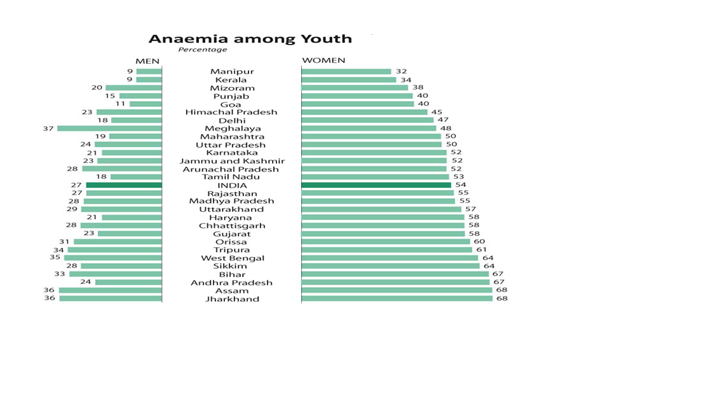With all the variety of foods available on city streets and malls one would imagine that urban youth is relatively well-fed and healthy. But data does not support this perception.
Undernourishment in India is highest among the youth. In urban areas, according to a survey-based estimate (NFHS –III) nearly half the population young men and women are abnormally thin. Poor nutrition is related to income. And this clearly accounts for the high-incidence of abnormally thin youth as one-fifth of urban India live in poverty (World Bank 2010). Within cities slum populations have slightly higher incidence of abnormally thin youth than non-slum population especially in metros like Mumbai and Delhi (NFHS-III).
One of the most common forms of malnutrition in the world is the iron deficiency anemia, which is characterized by a low level of hemoglobin in the blood. Anemia is of particular concern among women since this can become a primary cause for maternal and perinatal mortality which increases the risk of premature delivery and low birth weight children.
The above figure shows a wide variation in the prevalence of anemia among the Youth State wise. In most states at least one-half of young women are anemic and at least one-fifth of men are anemic.

Source: NFHS III
Proportion of women and men age 15-24 that have anemia by residence and city, India, 2005-06
City Women Men
Slum Non-slum Total Slum Non-slum Total
Delhi 52.1 46.5 47.7 24.7 15.5 17.8
Meerut 40.5 48.5 44.7 12.8 14.0 13.4
Kolkata 48.5 57.6 54.1 19.6 22.1 21.1
Indore 43.6 40.8 41.4 15.8 12.1 12.9
Mumbai 46.9 47.3 47.1 14.5 12.3 13.4
Hyderabad 58.1 49.2 50.8 16.6 11.1 12.1
Source: NFHS III
The above table shows that at least 4 in 10 female youth and at least 1 in 8 male youth are anemic in the seven cities under the survey. Women in Kolkata have the highest prevalence of anemia. More than half of women in Hyderabad and Chennai are anemic. Although there are differentials by slum/non-slum residence in anemia for both women and men, there is no consistent pattern that emerges, and a high proportion of women, in particular, are anemic irrespective of whether they live in a slum or a non-slum area.
There are factors which influence nutrition of youth and children like the infectious diseases which are an important and responsible factor for malnutrition and the poor environmental sanitation which leads to repeated cause for infection. The malnutrition and anemia is largely a by-product of poverty, ignorance, insufficient education, lack of knowledge regarding nutritive value of foods, large family size etc. These factors bear most directly on the quality of life and nutritional status of an individual. In some communities, men eat first and women eat last and poorly. Girls lose a considerable amount of iron during menstruation. Therefore, they require additional iron rich foods and supplements. Girls and young women are also discriminated against in both quantity and quality of food. Also, they are married early and suffer early pregnancy and child birth further compromising their nutritional status.
Reference:
Siddarth David, 2012. State of Urban Youth, India 2012 Employment, Livelihood, Skills
A Profile of Youth in India National Family Health Survey (NFHS 3) India 2005-06